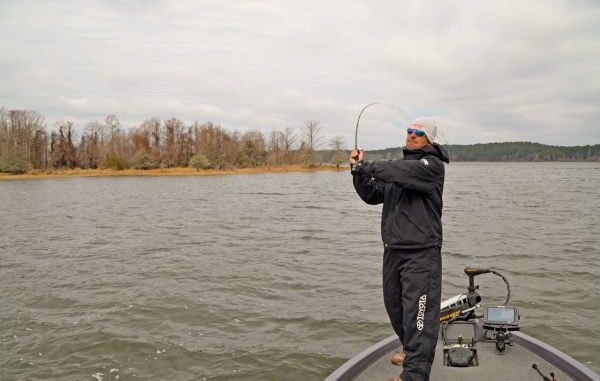
Originally patented as an Alabama Rig, it seems as if almost every bait maker now has a similar version of the contraption.
All carry their own names, but anglers often generically refer to all of them as “A-rigs.”
Darold Gleason’s favorite is the Fifth Element made by Shane’s Bait Company, which has several features that appeal to him.
“It is light in weight, so that with the added weights of the jigheads the combined weight doesn’t overpower you,” Gleason explained. “The other thing is that it has replacement arms. Fish can really mangle the arms of a rig. Bending them back into shape eventually makes them brittle, and they break.
“A whole harness, depending on the brand, can cost $15 to $20.”
Again, depending on the brand, the number of arms on a rig varies from three to nine. Gleason likes five arms rather than more because it gets through grass cover better.
Jighead size choice depends upon the depth of the water to be fished and the desired speed of retrieve. Heavier jigheads allow one to fish deeper and at higher speeds.
Normally, Gleason uses 1/8-ounce heads on the four outer arms and a ¼-ounce head on the center arm.
Because he considers it a big-fish lure, he likes big hooks — at least 4/0 on his jigheads.
Weedless jigheads also also be used in heavy cover.
His favorite plastics are V&M Lures Thunder Shad Juniors in pearl, pearl blue haze, white ice, and light hitch.
He always uses a different color (or a different size tail) on the center arm than on the other four.
He opts for a larger tail when the fishing action is strong or when he is fishing in a tournament. He added that fish home-in on the middle bait, especially when it is something a little bit different.
Gleason said using the right equipment for the rig is important. He recommended a 7 ½- to 8-foot heavy-action rod with a long handle.
His choice is a 7-foot, 6-inch, Falcon Bucoo.
A long handle on the rod provides a strong advantage when the rig comes in tangled (which is often the case) or with grass on the rig. He simply taps the handle with a clenched fist to jiggle the weeds off or straighten the lures.
The reel should carry a wide spool.
“It casts better and has more capacity,” Gleason said. “It needs strong gears to handle the heavy loads in this type of fishing.”
His choice is a Quantum Tour MG.
His A-rig reels are spooled with 60-pound-test Sunline braided line because it is so strong and has no stretch.
“The hooks on an A-rig are heavy and hard to sink home,” he said. “Also, it’s no small thing when you hang up. With heavy line, you can bend the hook before breaking the line. Ninety percent of the time, I can bend the hooks and then straighten them out with pliers, rather than lose the rig.”
The main key is that you have to use heavy equipment.
“Everything about A-rig fishing is beefed up,” Gleason said. “I seldom use heavy-action rods for anything else. For all my other fishing, I use fluorocarbon rather than braided line.”